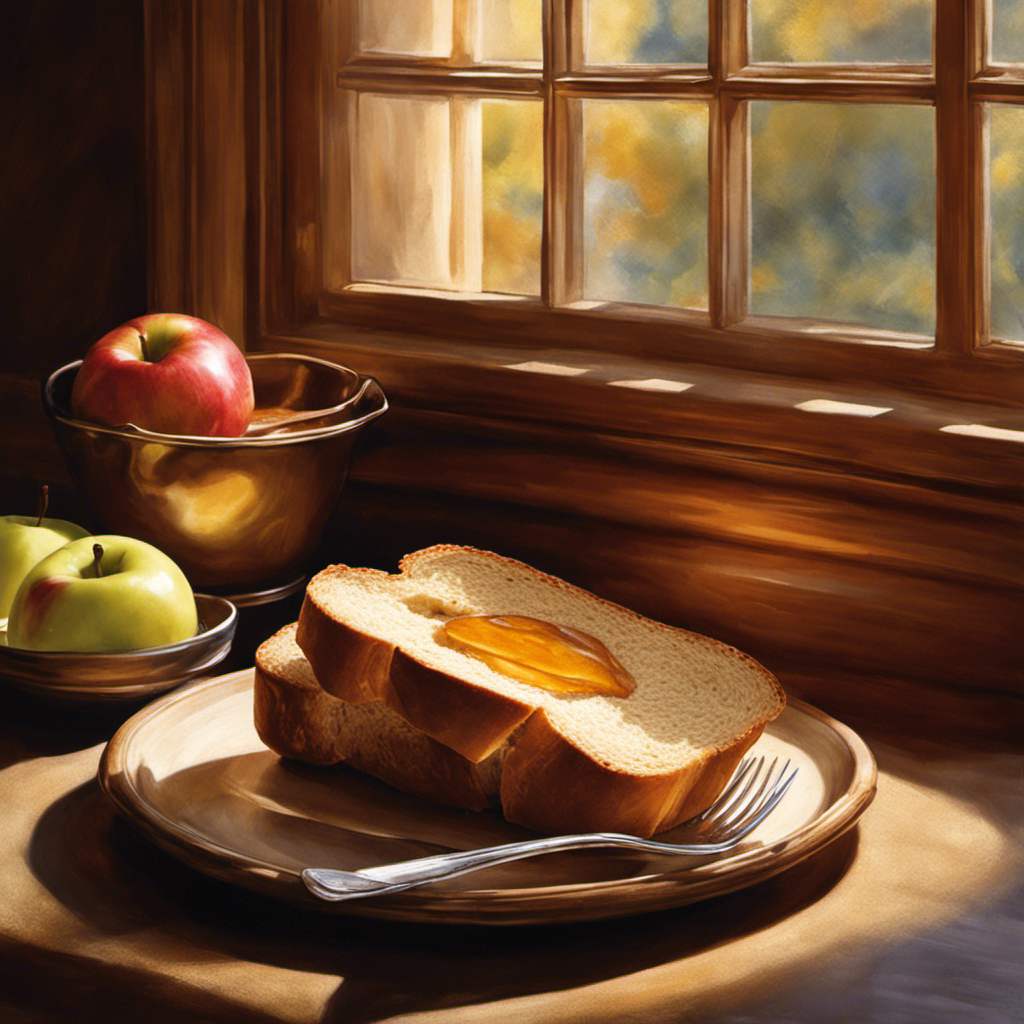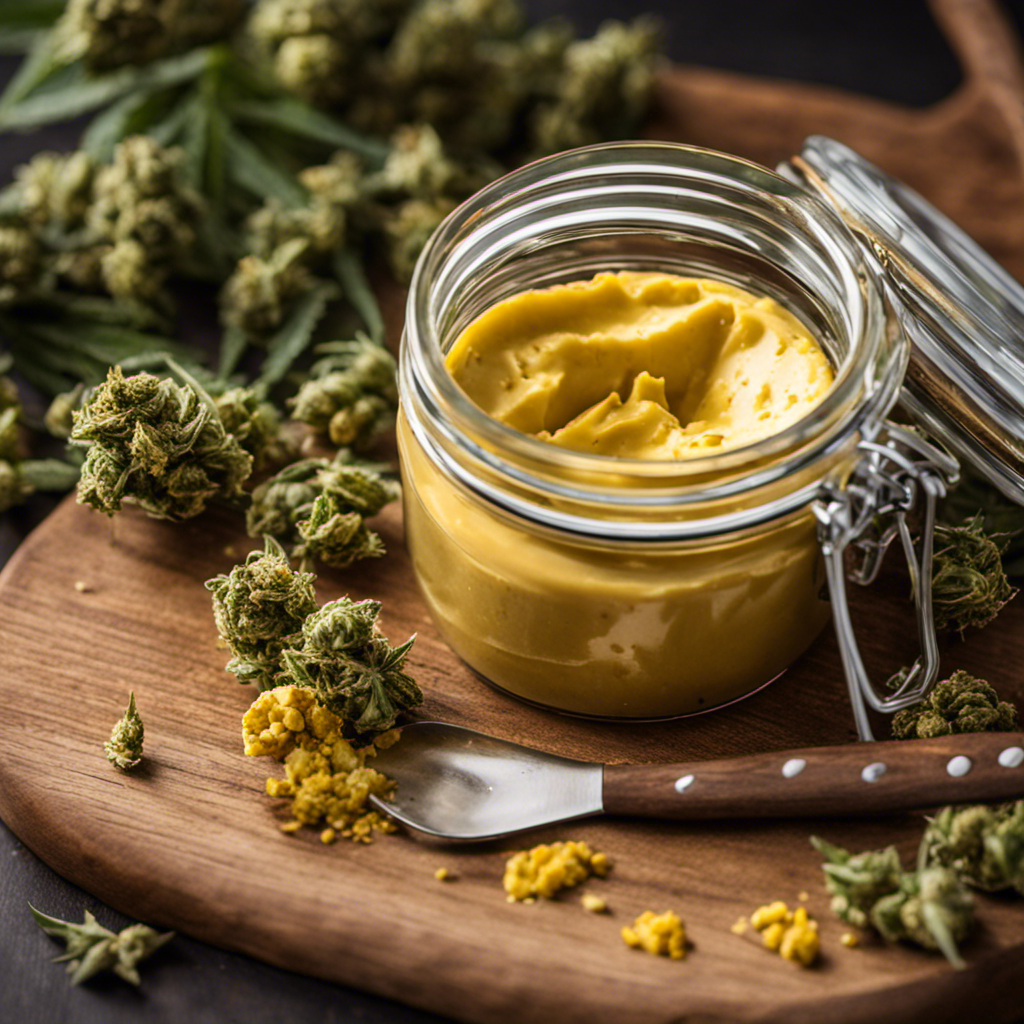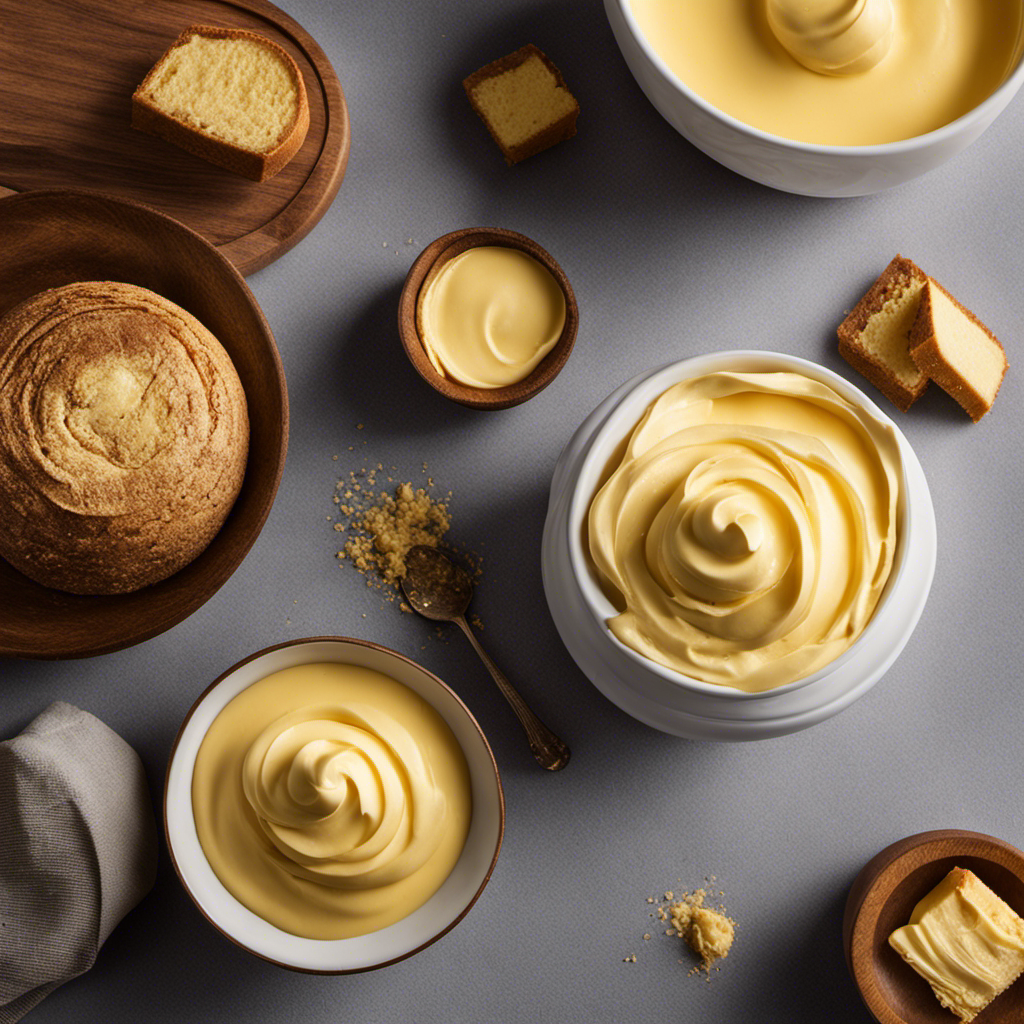As I bite into a piece of warm, buttered bread, I can’t help but reflect on the simple yet comforting essence of this traditional food. What is the true essence of bread and butter?
In this article, we will explore the origins, historical significance, cultural interpretations, and symbolic meanings associated with this phrase. From literature to idioms, from culinary references to social and economic implications, we will delve into every aspect to uncover the true essence of bread and butter in our lives.
So, let’s embark on this enlightening journey together.
Key Takeaways
- The phrase ‘bread and butter’ originated in the 18th century and refers to the basic necessities of life or a source of income.
- ‘Bread and butter’ is widely recognized and used in various cultures and languages, symbolizing sustenance, hospitality, and reliability.
- The production and sale of bread and butter generate significant revenue in the food industry, with employment opportunities and economic impacts extending beyond the sector.
- In literature and art, ‘bread and butter’ is used as a symbol of basic human needs, survival, and the mundane aspects of everyday life.
The Origin of the Phrase
The origin of the phrase ‘bread and butter’ can be traced back to the 18th century. It has its historical origins in the English language, where it was first used to describe the basic food items that were essential for survival. Bread and butter were considered staples in many cultures, and they symbolized sustenance and nourishment.
Over time, the phrase gained cultural significance and evolved into a metaphorical expression. It came to represent one’s main source of income or livelihood. Just as bread and butter were essential for survival, a steady income became crucial for people’s well-being.
Today, the phrase ‘bread and butter’ is commonly used to refer to one’s primary source of income or the foundation of one’s livelihood.
Historical Significance
During the early 19th century, bread and butter became a staple in the diets of many people. The historical origins of this culinary combination can be traced back to ancient times when bread was considered a basic necessity of life.
However, it was not until the rise of the dairy industry in the 19th century that butter became widely available and affordable.
The cultural significance of bread and butter lies in its simplicity and versatility. It has been a humble meal for the working class, a symbol of comfort and nourishment, and a traditional accompaniment to meals in many cultures around the world.
Today, bread and butter continue to hold a special place in our culinary traditions, reminding us of our shared history and the importance of basic sustenance.
Cultural Interpretations
Imagine how different cultures around the world have their own unique interpretations of the cultural significance of the combination of bread and butter. In many cultures, bread and butter symbolize nourishment and sustenance. However, the cultural symbolism and metaphorical interpretations of this humble combination go far beyond mere food. Let’s take a closer look at some examples from different parts of the world:
| Culture | Symbolism | Interpretation |
|---|---|---|
| Western | Comfort | Bread and butter represent comfort and familiarity in Western cultures. It is often associated with home and family. |
| Asian | Prosperity | In Asian cultures, the combination of bread and butter is seen as a symbol of prosperity and abundance, as both ingredients are considered luxurious. |
| Middle Eastern | Hospitality | In Middle Eastern cultures, offering bread and butter to guests is a sign of hospitality and generosity. It is a way of welcoming visitors into one’s home. |
| African | Unity | In many African cultures, bread and butter are seen as symbols of unity and community. Sharing a meal of bread and butter signifies coming together and fostering relationships. |
These interpretations show how the cultural significance of bread and butter goes beyond its literal meaning, reflecting the values and traditions of different societies.
Bread and Butter in Literature
When exploring symbolic meanings in literature, one interesting metaphor that often arises is the concept of ‘bread and butter.’ This metaphor, which refers to something that is essential or fundamental, can be found in various literary works.
Through careful analysis and interpretation, we can uncover the deeper layers of meaning behind these references, shedding light on the themes and messages conveyed by the authors.
Symbolic Meanings in Literature
You may be familiar with the phrase ‘bread and butter,’ but did you know that it can also have symbolic meanings in literature?
Symbolic interpretations of ‘bread and butter’ in literature often revolve around its cultural significance. Bread and butter, as a symbol, represents sustenance, basic needs, and survival. It is deeply rooted in our cultural understanding of essential nourishment.
In literature, this symbol can be used to convey themes of stability, comfort, and security. It can also be employed to highlight the struggles and hardships faced by characters when these basic needs are threatened or unmet.
The cultural significance of ‘bread and butter’ adds depth and relatability to the narrative, resonating with readers on a primal level. Through the symbolic use of ‘bread and butter,’ authors can explore universal human experiences and evoke strong emotions in their readers.
Bread and Butter Metaphor
If you’re a fan of literature, you’ve likely encountered the bread and butter metaphor used to convey essentiality and everyday necessities. The bread and butter symbolizes the basic elements that are vital for survival and sustenance.
This metaphorical interpretation can be found in various literary works, where authors use it to emphasize the fundamental aspects of life. The bread represents sustenance, nourishment, and the bare necessities, while the butter symbolizes the added richness and enjoyment that can be found in life.
This metaphor can be seen in different contexts, such as relationships, careers, or personal growth. It highlights the importance of both the basic necessities and the little luxuries that enhance our existence.
Literary References and Interpretations
Literary references and interpretations are abundant in works of literature, adding depth and complexity to the overall meaning. This is especially true when it comes to the use of literary symbolism and metaphorical interpretations. These techniques allow authors to convey deeper meanings and evoke emotions in their readers.
Here are five examples of how literary symbolism and metaphorical interpretations enhance the power of literature:
-
In ‘To Kill a Mockingbird,’ the mockingbird is a symbol of innocence and compassion, highlighting the injustice and cruelty of society.
-
In ‘The Great Gatsby,’ the green light represents the elusive American Dream, symbolizing both hope and unattainability.
-
In ‘Moby-Dick,’ the white whale symbolizes the unknowable and mysterious forces of nature, as well as the protagonist’s obsessive pursuit.
-
In ‘The Scarlet Letter,’ the scarlet letter itself is a symbol of sin and shame, affecting the lives of the characters and exploring the moral complexities of society.
-
In ‘1984,’ the concept of Big Brother represents a metaphorical interpretation of totalitarianism and government control, warning against the dangers of a surveillance state.
These examples demonstrate how literary symbolism and metaphorical interpretations enrich the reading experience, allowing readers to delve deeper into the themes and messages of a work.
Symbolic Meanings
The symbolic meanings of the phrase ‘bread and butter’ are often associated with basic necessities or a source of livelihood. In various cultures, bread and butter hold significant interpretations that reflect the importance of sustenance and stability. For instance, in Western culture, the phrase is commonly used to describe one’s primary source of income or a steady job. This signifies the fundamental role that bread and butter play in providing for one’s basic needs. Additionally, bread and butter hold cultural significance in religious practices and rituals. In Christianity, bread is seen as a symbol of the body of Christ, while butter symbolizes richness and prosperity. This symbolism emphasizes the spiritual and material nourishment that bread and butter represent. The table below illustrates the diverse cultural interpretations of the phrase ‘bread and butter.’
| Culture | Symbolic Interpretation | Cultural Significance |
|---|---|---|
| Western | Source of income | Economic stability |
| Christianity | Spiritual nourishment | Prosperity |
| Eastern | Basic necessities | Sustenance |
Bread and Butter in Idioms
In exploring the symbolic meanings of the bread and butter metaphor, it’s important to delve into its usage in idioms. Idioms are phrases that have a figurative meaning different from their literal interpretation. Here are five intriguing idioms that incorporate the bread and butter metaphor:
- ‘To earn one’s bread and butter’: This idiom refers to making a livelihood or income through one’s profession or work.
- ‘To be the bread and butter of something’: This phrase implies that someone or something is essential for the success or sustenance of a particular endeavor.
- ‘To take the bread out of someone’s mouth’: This idiom signifies depriving someone of their means of subsistence or livelihood.
- ‘To know which side one’s bread is buttered on’: This idiom suggests being aware of one’s best interests or recognizing where one’s advantages lie.
- ‘To butter someone up’: This phrase means to flatter or be excessively nice to someone in order to gain favor or advantage.
These idioms highlight the significance of bread and butter in our language, reflecting the implications of income inequality and the value placed on sustenance and livelihood.
Now, let’s delve into the culinary references associated with bread and butter.
Culinary References
Let’s explore the delicious culinary references related to bread and butter.
Culinary traditions around the world have long embraced bread and butter as staple ingredients in various dishes. From French cuisine to American classics, bread and butter play a vital role in enhancing flavors and adding richness to a wide range of recipes.
In French cooking, the technique of ‘beurre manié’ involves blending butter and flour to create a thickening agent for sauces and soups.
In Italian cuisine, bruschetta, a popular antipasto, showcases the combination of crusty bread and buttery toppings like tomatoes, garlic, and olive oil.
In American Southern cooking, biscuits and gravy are a beloved comfort food, with flaky biscuits slathered in creamy butter and smothered in a savory sausage gravy.
These culinary traditions and cooking techniques demonstrate the versatility and importance of bread and butter in enhancing flavors and creating memorable dishes.
Social and Economic Implications
When considering the social and economic implications of income inequality, it is important to examine its effects on various aspects of society.
One key point to explore is the impact on individuals and communities, as income inequality can lead to a widening wealth gap and limited opportunities for upward mobility.
Additionally, income inequality can also shape social class dynamics, reinforcing divisions between the rich and poor and leading to social stratification.
Income Inequality Effects
You should consider the effects of income inequality on society. Income inequality has far-reaching consequences that impact various aspects of society and perpetuate social class dynamics. Here are five key effects of income inequality:
-
Limited upward mobility: High levels of income inequality can make it difficult for individuals from lower-income backgrounds to move up the social ladder, creating a disparity in opportunities and perpetuating the cycle of poverty.
-
Social unrest: Income inequality can lead to social unrest and dissatisfaction among marginalized groups, resulting in protests, demonstrations, and even violence.
-
Health disparities: Lower-income individuals often have limited access to quality healthcare, leading to higher rates of illness and shorter life expectancies compared to those with higher incomes.
-
Education gap: Income inequality can widen the educational gap, as children from disadvantaged backgrounds may not have access to quality education and resources, further entrenching the divide between the rich and the poor.
-
Political influence: Wealthier individuals and corporations often have more political influence due to their financial resources, leading to policies that favor the interests of the rich and exacerbate income inequality.
These effects illustrate the importance of addressing income inequality to promote a more equitable and inclusive society.
Social Class Dynamics
Understanding social class dynamics is crucial in comprehending the complex interactions and power dynamics between different socioeconomic groups. Class mobility, or the ability to move up or down the social ladder, plays a significant role in shaping these dynamics.
It is important to recognize that social class is not static, and individuals can experience upward or downward mobility throughout their lives. Status symbols, such as luxury goods or prestigious job titles, often serve as markers of social class and can influence how individuals are perceived and treated by others.
However, it is important to note that social class is not solely determined by material possessions, but also by factors such as education, occupation, and cultural capital.
Economic Stability Impact
To fully grasp the impact of economic stability, it’s essential to consider how fluctuations in the economy can affect individuals and their overall well-being.
-
Economic stability provides a sense of security and peace of mind. It allows individuals to plan for the future with confidence.
-
Economic stability reduces stress and anxiety related to financial struggles. When the economy is stable, people are less likely to worry about losing their jobs or struggling to make ends meet.
-
It promotes investment and entrepreneurship, leading to economic growth. When the economy is stable, businesses are more willing to invest in new ventures and individuals are more likely to start their own businesses.
-
Economic stability helps in reducing income inequality by providing equal opportunities for all. When the economy is stable, individuals have a better chance of finding stable employment and earning a fair income.
Economic stability is crucial for individuals and society as a whole. When the economy is stable, people are more likely to have stable jobs, secure incomes, and access to essential resources. This stability not only improves the quality of life for individuals but also reduces income inequality by providing equal opportunities for all.
Now let’s explore the modern usage and relevance of economic stability.
Modern Usage and Relevance
If you’re wondering about the modern usage and relevance of the phrase ‘bread and butter,’ it’s often used to describe someone’s main source of income or livelihood. In everyday life, this phrase has become deeply ingrained in our vocabulary. We use it to discuss our jobs, careers, and financial stability. It represents the essential aspect of our lives that provides us with the means to survive and thrive.
Furthermore, ‘bread and butter’ has also made its way into popular culture. It is frequently used in movies, TV shows, and songs to convey the idea of something fundamental and necessary. This phrase has transcended its literal meaning and has become a metaphorical representation of our basic needs and the means to fulfill them.
In a fast-paced and ever-changing world, ‘bread and butter’ remains a vital concept that holds great significance in our lives.
Frequently Asked Questions
How Many Different Idioms Are There That Involve the Phrase "Bread and Butter"?
There are several idioms involving the phrase "bread and butter." These idioms have different cultural interpretations and historical origins. They can be found in various languages and are used to describe different aspects of life.
Are There Any Specific Literary Works That Prominently Feature the Phrase "Bread and Butter"?
In literary works, the phrase "bread and butter" is used allegorically to represent basic necessities or means of survival. It has historical significance in culinary references as a staple food.
What Are Some Common Culinary References Related to Bread and Butter?
In culinary traditions, bread and butter hold historical significance. They have been staples in many cultures for centuries, symbolizing basic sustenance and comfort. The combination of warm bread and creamy butter is universally loved and enjoyed.
How Has the Social and Economic Landscape Affected the Perception of Bread and Butter?
In today’s fast-paced world, the perception of bread and butter has been influenced by the social and economic landscape. Changing dietary trends have impacted its popularity, leading to a shift in how we view this culinary staple.
What Are Some Contemporary Examples of the Phrase "Bread and Butter" Being Used in Modern Contexts?
Contemporary usage of ‘bread and butter’ in business and entrepreneurship reflects the historical origins and cultural significance of the idiom. It refers to the fundamental source of income or sustenance, essential for success in any endeavor.
Conclusion
In conclusion, the phrase ‘bread and butter’ holds a significant historical and cultural meaning. It has been used in literature to symbolize sustenance and stability, and has been incorporated into various idioms to convey different messages.
Culinary references to bread and butter highlight its importance in daily life, both socially and economically.
In modern usage, the phrase still holds relevance, reminding us of the basic necessities that provide us with a sense of security. Interestingly, studies have shown that 1 in 5 people worldwide lack access to reliable and nutritious food, emphasizing the importance of bread and butter in our lives and the need to address global food insecurity.










